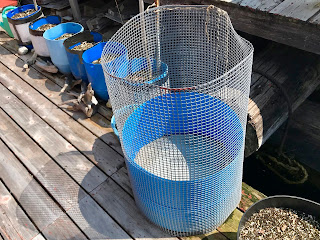Book Review: "Murder Rides a Gale Force Wind" by Yvonne Maximchuk
 |
| The author/artist in action at our float cabin. |
Yvonne is an author and artist. She's a master at capturing the beauty of Coastal BC in images and words. You can see more at her website.
Murder Rides a Gale Force Wind is set in Echo Bay, nearby islands and North Vancouver Island. If you've read any of Yvonne's other books, you'll recognize her inspiration from real-life people and places like the Echo Bay Marina and Lodge and legendary Billy Proctor.
Review of Murder Rides a Gale Force Wind
Echo Bay is a small hamlet of cabins in a protected cove cut off from Vancouver Island by kilometres of sometimes dangerous ocean. Like all small villages, everyone knows everyone, sometimes too well. Woody's lodge and marina is the heart of the community. It's usually a quiet place, except when summer boaters come to cruise the nearby scenic waterways. In all seasons, it supplies residents and fishermen with fuel, mail, supplies and gossip.Tim is a colourful character. He's settled into being a government agent checking prawn boats for legal catches. He has conflicting love interests, Margaret an RCMP Sargent in Port McNeill on Vancouver Island, and Kit who runs a boat taxi service out of Echo Bay. There's also a tangled web of other characters from Echo Bay, the First Nations village, and recent arrivals to this isolated region.
Several story lines unfold to introduce the characters and the beautiful land and sea. They come together crashing together when a body is discovered washed up on the shore of a neighbouring island. The big question, is it murder or something else.
Yvonne knows this area well. It's been her home for many years. Her extensive knowledge of boating, off-grid living, commercial fishing, logging, painting, First Nations, hiking and exploring shows in her descriptive narration. I'm amazed at how much I have learned over the years by living in the region. For some readers, a few terms might be unfamiliar, but add to the authenticity.
Congratulations to Yvonne on an exciting novel. You are a master of words to paint pictures in the minds of your readers.
Murder Rides a Gale Force Wind is available in e-book and print formats from a variety of online booksellers plus several Vancouver Island and Lower Mainland bookstores. Watch her Facebook page for upcoming in-person readings and presentations.
Posts I've written about Yvonne and her books:
Yvonne Maximchuk: Painter, Potter, Author and her visit to our Powell Lake float cabin
Her memoir Drawn to Sea
Books co-authored with Bill Proctor: Full Moon, Flood Tide and Tide Rips and Back Eddies
 Visit the monthly Book Review Club for teen/young adult and adult fiction over at Barrie Summy's blog.
Visit the monthly Book Review Club for teen/young adult and adult fiction over at Barrie Summy's blog.Also shared with Your the Star at Stone Cottage Adventures.





























































